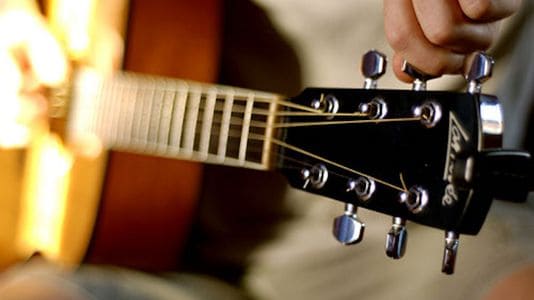TheGuitarLesson.com
This post appeared first at Guitar Tuning Tips and Tricks on TheGuitarLesson.com, thanks for reading.
Learning how to tune your guitar, and keeping it in tune is one of the most important technical elements of playing the guitar.
If your guitar is not in tune, you simply won’t be able to hit the notes you want, or play the songs you love, since it will all sound out of tune. Sort of like when an amateur singer performs at karaoke night 

No worries though, learning to tune your guitar is as easy as 1,2,3.
First of all, watch our video tutorial on how to tune a guitar, it will show you the basic technique with an electric tuner, and without one as well (if you want to tune by ear). To tune by ear, you’ll need a reference note, for which you can use our online guitar tuner.
Once you learn guitar tuning, make sure you keep it in tune afterwards as well. Here are some helpful guitar tuning tips for you:
- Tune upwards – The correct method of tuning is to go a bit below the desired pitch (loosen the string), than go up to the right pitch (tighten the string). Doing this will help avoid the string getting out of tune, and becoming flat during play. Your final twist of the peg should always make the string tighter. Of all these guitar tuning tips, this is most important since so many people get it wrong.
- Guitar strings stretch and shrink when exposed to heat and cold. Avoid leaving your guitar in extreme temperature conditions, or if you do, make sure you retune before you start playing again.
- Once you start playing at gigs where you play lots of songs, check your guitar’s tuning between songs. Most effect pedals have built in tuners for this purpose, which comes in very handy. There’s nothing worse than a “professional” musician who is out of tune.
- After getting new strings, you’ll need to tune more frequently until your strings stretch into place.
- If your electric guitar has a tremolo arm fitted onto it, you’ll need to tune more regularly, as the tremolo stretches your strings when in use.
- If you are tuning in a noisy environment, use a tuner that can be plugged into your guitar. Most good electronic tuners have both an internal microphone and the ability to be connected to a guitar with a jack cable.
- Turn your tuning pegs carefully. If you play your guitar regularly, you’ll only need to slightly retune without larger twists of the pegs.
- Don’t leave your guitar with its neck resting on the ground. The tuning pegs will invariably brush up against the surface and turn by accident. Get a guitar stand!
- It’s best practice to tune your guitar every time you pick it up.
- Tuning with your ear is good and will help you develop a musicians ear, so once you’ve played enough and can hear pitch alterations, first tune by ear, than maybe double check with an electric tuner.
By keeping the above advice in mind, you’ll always have a guitar thats in tune. If you’re a beginner guitarist, get an electric guitar tuner, it’ll make life a whole lot easier.
TheGuitarLesson.com is your source for beginner guitar lessons.
Read More
This article is from an external source and may contain external links not controlled by Empeda Music.

